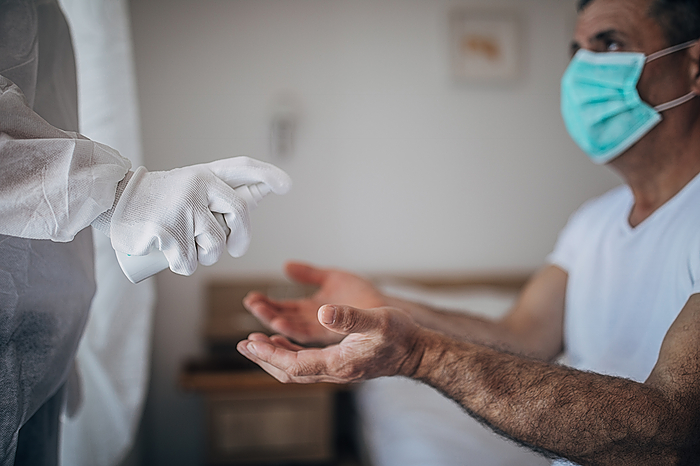How a Coronavirus Infection Progresses Through the Body

What does a coronavirus infection feel like? How would I know if I have it? These are among the most frequently asked and searched for questions impacting our community (and the world) at the moment.
We spoke with Olveen Carrasquillo, M.D., an internal medicine expert at the University of Miami Health System, to provide a timeline of what the medical research community currently knows about how a COVID-19, or Coronavirus infection, would impact the average human body.
The trajectory of infection may look like this, depending on your risk factors:
- The virus enters the body: This occurs primarily through physical contact or inhalation, entering the body through the nose, mouth, or eyes. The virus lives in droplets released by an infected person when they cough or sneeze, and can be transmitted by touch – staying alive on surfaces touched by an infected individual. This is why handwashing, sanitizing, and social distance are critical, and strongly recommended to control and mitigate further contagion. Once the virus enters the body, it begins to attack.
- The viral attack begins internally: Once inside the body, the virus begins infecting epithelial cells in the lining of the lung through a protein on the viral cell’s receptors, which attach to and penetrate a host cell. Inside the host cell, the virus begins to replicate until it kills the cell. This begins in the upper respiratory tract (nose, mouth, larynx, and bronchi.)
- Symptoms begin in the upper respiratory tract: It can take several days for a person to develop symptoms after initial exposure to the virus, with the average being about five days. The most common symptoms are cough and fever but can also include muscle pain and tiredness – similar to the flu.
- The WHO reported that about 80% of patients have a mild to moderate infection, which is mostly contained to the upper respiratory tract and limited to the above symptoms (fever, cough, aches) that do not require hospitalization. In many cases, infected individuals within this 80% of cases – particularly those that are otherwise healthy – may not even experience any symptoms. However, these individuals are still infectious and at risk of transmitting the virus to more vulnerable individuals, which may experience more critical cases of the infection.
- Symptoms worsen if the virus enters the lower respiratory tract: About 20% of the population can get severe symptoms, including about 5% that may require critical care. These cases tend to occur when the virus enters the lower respiratory tract – in other words, the virus enters a patient’s lungs resulting in pneumonia, and in critical patients, a condition we call acute respiratory distress syndrome.
- Severe infection occurs (in an estimated 20% or fewer cases): While most patients infected by COVID-19 are not likely to experience these complications to the lower respiratory tract (lungs), the key risk factors for these more critical cases of infection include age (over 80 years old) and pre-existing conditions (cancer, diabetes, pregnancy, and chronic disease/disorders that may compromise the immune system). However, we are seeing that even younger patients in their 50’s and 60’s are at increased risk.
- Pneumonia may be marked by shortness of breath and a deep cough. Pneumonia damages the tiny air sacs in the lungs – the alveoli – which thicken as they try to fight off the infection. This thickening is what decreases the air pocket responsible for getting oxygen into the blood system – and ultimately shortens and constricts an individual’s ability to breathe.In the event that an individual begins to feel these symptoms: persistently high fever, shortness of breath, or chest pain – it is advised that you visit the emergency room for treatment.
Is there anything we can do to minimize the intensity of an infection?
“Unfortunately not – once we have the infection, there is little we can do to minimize it, based on existing data,” says Dr. Carrasquillo. He encourages some patients who want to take Vitamin C supplements, or get daily sun exposure for Vitamin D absorption, to go ahead and do it, for personal benefit (and peace of mind). However, current data does not support the efficacy of supplements or even anti-malarial medication for the treatment of COVID-19 in otherwise healthy patients.
Our best strategy is still prevention of both personal and wider infection:
- Wash and sanitize your hands frequently. Wash them for at least 15-20 seconds, and use hand sanitizers with at least 62% alcohol if no soap and water is available
- Sanitize frequently touched surfaces – including countertops and your cell phone
- Maintain a balanced, diverse diet heavy in fresh vegetables and fruits
- Exercise regularly
- Honor the quarantine recommendation to reduce the likelihood of infection, particularly to the most vulnerable among us that may fall into the 20% of severe and critical cases.
- Stay home, especially if experiencing any symptoms cited above
- Maintain a social distance when in public settings (6 feet or more)
- Contact your doctor if you begin to experience shortness of breath or difficulty/pain when breathing
Written by Paloma Vazquez, contributor to UMiami Health News.
